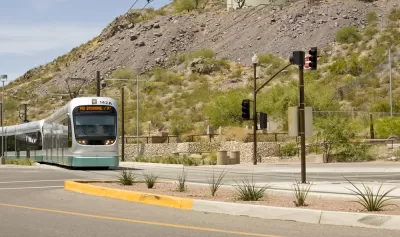A new report finds that residents of Arizona are driving less—much, much less. Arizonans drive less that they did in the 1990s, in fact. Despite these trends, the state government has not adjusted its traffic forecasting models.

Angie Schmitt shares new of a new report, "Bikes, Trains, and Less Driving [pdf]," by the Arizona Public Interest Research Group.
Here's how the report sums up its findings: "Between 2005-2012, Arizona saw a 10.5 percent decline in annual vehicle miles traveled per capita. Arizonans drive fewer total miles today than seven years ago, and fewer per person than we did in 1994."
Two of the report's takeaways, as identified by Schmitt:
- "In notoriously sprawling Phoenix, people are starting to ditch their cars. Between 2006 and 2011, the share of households with two or more vehicles decreased 2.9 percent, PIRG reports. And the total number of cars and trucks on the state’s roads is dropping, even as the population grows."
- "Meanwhile, transit ridership is on the rise in Arizona’s major cities. In Phoenix, between 2005 and 2010, total transit trips increased 16 percent. "
Schmitt also makes a point about how the trends in reduced VMT have yet to drive planning policy change at the state level.
FULL STORY: Arizonans Driving Like It’s 1994

Planetizen Federal Action Tracker
A weekly monitor of how Trump’s orders and actions are impacting planners and planning in America.

Map: Where Senate Republicans Want to Sell Your Public Lands
For public land advocates, the Senate Republicans’ proposal to sell millions of acres of public land in the West is “the biggest fight of their careers.”

Restaurant Patios Were a Pandemic Win — Why Were They so Hard to Keep?
Social distancing requirements and changes in travel patterns prompted cities to pilot new uses for street and sidewalk space. Then it got complicated.

Platform Pilsner: Vancouver Transit Agency Releases... a Beer?
TransLink will receive a portion of every sale of the four-pack.

Toronto Weighs Cheaper Transit, Parking Hikes for Major Events
Special event rates would take effect during large festivals, sports games and concerts to ‘discourage driving, manage congestion and free up space for transit.”

Berlin to Consider Car-Free Zone Larger Than Manhattan
The area bound by the 22-mile Ringbahn would still allow 12 uses of a private automobile per year per person, and several other exemptions.
Urban Design for Planners 1: Software Tools
This six-course series explores essential urban design concepts using open source software and equips planners with the tools they need to participate fully in the urban design process.
Planning for Universal Design
Learn the tools for implementing Universal Design in planning regulations.
Heyer Gruel & Associates PA
JM Goldson LLC
Custer County Colorado
City of Camden Redevelopment Agency
City of Astoria
Transportation Research & Education Center (TREC) at Portland State University
Camden Redevelopment Agency
City of Claremont
Municipality of Princeton (NJ)



























